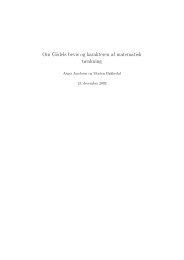Master Dissertation
Master Dissertation
Master Dissertation
Create successful ePaper yourself
Turn your PDF publications into a flip-book with our unique Google optimized e-Paper software.
〈y, y〉 = det σ(y) = det A det σ(x) det A ∗ = det σ(x) = 〈x, x〉.<br />
Clearly the parallelogram identity holds for the Lorentz metric 2 , thus<br />
〈x, y〉 =<br />
= det σ(x) + det σ(y) − det σ(x) − det σ(y)<br />
〈x + y, x + y〉 − 〈x, x〉 − 〈y, y〉<br />
2<br />
.<br />
2<br />
From this we see that 〈ΛAx, ΛAy〉 = 〈x, y〉, thus it is a Lorentz<br />
transformation.<br />
Since<br />
fixme: make sure the following is correct<br />
Hence<br />
ΛB(x) = y ⇔ σ(y) = Bσ(x)B ∗ and ΛA(y) = z ⇔ σ(z) = Aσ(y)A ∗ ,<br />
ΛAB(x) = z ⇔ ABσ(x)B ∗ A ∗ = Aσ(y) = σ(z).<br />
ΛAB = ΛAΛB.<br />
In this way we can construct a representation Λ : A ↦→ ΛA of SL(2, C), the<br />
group of all complex 2 × 2 matrices with determinant 1, onto L ↑<br />
+ . We call<br />
SL(2, C) the spinor representation. The vectors in the representation space<br />
C2 are called spinors.<br />
Note that the kernel of the representation Λ is<br />
ker Λ = Λ −1 ({I4}) = {A ∈ SL(2, C)|AHA ∗ for all H ∈ H(2)}.<br />
Letting H = I2 we see that A ∈ ker Λ must be unitary and A ∈ ker Λ if and<br />
only if AH = HA for all H ∈ H(2). Hence A = −I2 or A = I2 and<br />
L ↑<br />
+ ∼ = SL(2)/{I2, −I2}.<br />
Hence Λ(A) = Λ(−A) and SL(2, C) is a two-valued representation of L ↑<br />
+ .<br />
2 The proof is exactly the same as the usual one for inner product spaces.<br />
18



